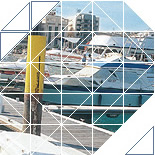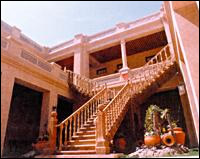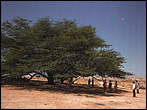|
|
 |
| |
Attractions
Bahrain
National Museum
Built in 1988, the Bahrain National Museum displays a series
of collections that tell the fascinating story of Bahrain's
past, from the Stone Age right up to recent times. Exhibits
include rare manuscripts from the 13th century AD and original
documents from the 14th century AD. Other exhibits include
reproductions of handicrafts and skills associated with
pearling, gold jewellery, weaving and boat-building, costumes,
specimens of Bahrain's natural history, photographs and
contemporary works of art.
www.bnmuseum.com |
|
 |
Currency
Museum
Housed at the Bahrain Monetary Agency (BMA), the currency
museum has the ancient Arab, Islamic and Byzantine coins
minted of gold and silver. The Museum houses one of the
nine rarest Islamic currency coins in the world. The Museum
is of great benefit to currency collectors.
http://www.bma.gov.bh |
Oil
Museum
Bahrain was the first country to discover oil in the Arabian
Gulf region. The Oil Museum was officially inaugurated
in 1992 and is located near the first oil well discovered
in 1932 in Sakhir. It houses old drilling equipment, samples
of rocks found underground, topographical maps and some
information about the companies that had participated
in the exploration for oil. |
|
 |
Museum
of Pearl Diving
Pearl diving has been one of the major occupations in
Bahrain since ancient times. Bahrain pearls are marked
by their high quality, probably due to the abundance of
sweet water wells found on the seabed. The Museum consists
of several exhibition halls displaying various aspects
of Bahrain's daily life in the pre-oil period. Such
aspects include pearl diving, national costumes, local
musical instruments, a typical wedding chamber, domestic
games, archive photographs, local herbal medicinal practices
and the High Court Chamber, which has been maintained
intact since 1937. |
Grand Mosque
The Mosque is built with exquisite Bahraini architecture.
Non-Muslim visitors are welcome.
http://www.beitalquran.com |
|
 |
Tree
of Life
The Tree of Life stands alone in the centre of the desert
without any known water source. The tree is believed to
be from the Acacia family, sheds its leaves in winter
but grows yellow flowers in spring and autumn. The mystery
has raised the curiosity of visitors and specialists alike
for many years. |
Bahrain
Fort
The Bahrain Fort, situated at Karbabad, also known as
the Portuguese Fort, is of great historical importance
in the Arabian Gulf region. The Fort was built by the
Portuguese in 1522 on the ruins of an earlier small fort
built by the people of Bahrain. The Portuguese added the
high walls, the huge square towers and a surrounding moat
which is still visible to visitors. |
|
 |
Shaikh
Salman bin Ahmed Al-Fatih Fort
Built by Shaikh Salman bin Ahmed Al-Fatih in 1812, the
Fort sits on a high vantage point overlooking the surrounding
desert. It was used by Shaikh Salman as his seat of government.
The Fort has four towers in the corners, two of them are
circular and the other two are square. The towers are
connected to each other by an overhead passage and contain
residential chambers and associated facilities. It is
believed that the Fort was built on the ruins of an earlier
1698 castle. |
|
|
|
 |
 |
 |
 |
 |
 |
 |
| |
|
|
